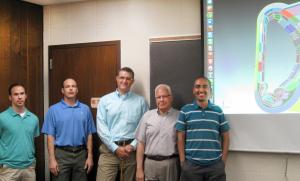Predicting the neutrons' impact
22 Jun 2012
-
Lynne Degitz, US ITER
Standing in front of a neutronics model of ITER: (left to right) Ed Marriott, Tim Bohm, Paul Wilson, Mohamed Sawan and Ahmad Ibrahim, US ITER researchers at the University of Wisconsin.
US ITER researchers at the University of Wisconsin and Oak Ridge National Laboratory are developing advanced processes to assess ITER's unique tokamak components and materials in the presence of the tremendous amount of neutron flux and energy released by fusion reactions. The process, called neutronics analysis, involves a palette of complex computational codes and libraries for predicting neutron impacts.


